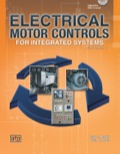
EBK ELECTRICAL MOTOR CONTROLS FOR INTEG
5th Edition
ISBN: 8220101434760
Author: ROCKIS
Publisher: ATP
expand_more
expand_more
format_list_bulleted
Concept explainers
Question
Chapter 3.2, Problem 7CP
To determine
To explain: Which type of current measurement that would never be taken on circuit that might contain high or unknown currents.
Expert Solution & Answer
Want to see the full answer?
Check out a sample textbook solution
Students have asked these similar questions
B:Find the roots of the following equation using NR method at the end of second iteration.start
with V-4, V2S
V₁*V2=50...
V₁+V₂ =15
(1)
a) Determine the setting of the overload protection of the circuit breaker intended to protect a 50hp, 380V, IV-pole motor, powered by a unipolar copper-PVC conductor circuit, with a cross-section of 25mm², installed in a buried conduit: The short-circuit current at the motor terminal is 5KA. It is assumed that the overload current of the conductor throughout its useful life is controlled and will not exceed 100 hours for 12 consecutive months or 500 hours throughout the useful life of the conductor. Data: fp = 0.86; efficiency = 0.92
a) Determine the minimum operating time of the circuit breaker in the event of a short-circuit at the motor terminals.
Q1:A: Derive four elements only of diagonals Jacobian matrix of NR method in polar coordinate
for a system consist of 4 buses, bus 1 is slack and the other three buses are PQ buses.
Chapter 3 Solutions
EBK ELECTRICAL MOTOR CONTROLS FOR INTEG
Knowledge Booster
Learn more about
Need a deep-dive on the concept behind this application? Look no further. Learn more about this topic, electrical-engineering and related others by exploring similar questions and additional content below.Similar questions
- Find the valve of voltage V, and Va using LOOP analys is C ЗА Mw 8 ДАДА 2 Am 4 38 + V Z 4 5A 34 2 12Varrow_forward1. For the following logic gates: a. Write a Truth Table and logic equation? A Y A A. Y A Y "0" A A neotoof "0"> Day Y "1" A ADY DY A B DD A B b. What each of these gates represent? 2. Connect and draw the following digital logic equations: a. Y=X+1 b. Y=X+X' = \ c. Y=X X' d. Y=X 0 e. Y=XX' f. Y=XOX 3. Prove that: a. X(Y+Z)=XY+XZ b. X+YZ=(X+Y)(X+Z) c. (X+Y)'=X'Y' d. (XY)'=X'+Y e. X+XY=X f. X(X+Y)=Xarrow_forwardI need help with this problem and an step by step explanation of the solution from the image described below. (Introduction to Signals and Systems: Spectrum Representation)arrow_forward
arrow_back_ios
SEE MORE QUESTIONS
arrow_forward_ios
Recommended textbooks for you
 Introductory Circuit Analysis (13th Edition)Electrical EngineeringISBN:9780133923605Author:Robert L. BoylestadPublisher:PEARSON
Introductory Circuit Analysis (13th Edition)Electrical EngineeringISBN:9780133923605Author:Robert L. BoylestadPublisher:PEARSON Delmar's Standard Textbook Of ElectricityElectrical EngineeringISBN:9781337900348Author:Stephen L. HermanPublisher:Cengage Learning
Delmar's Standard Textbook Of ElectricityElectrical EngineeringISBN:9781337900348Author:Stephen L. HermanPublisher:Cengage Learning Programmable Logic ControllersElectrical EngineeringISBN:9780073373843Author:Frank D. PetruzellaPublisher:McGraw-Hill Education
Programmable Logic ControllersElectrical EngineeringISBN:9780073373843Author:Frank D. PetruzellaPublisher:McGraw-Hill Education Fundamentals of Electric CircuitsElectrical EngineeringISBN:9780078028229Author:Charles K Alexander, Matthew SadikuPublisher:McGraw-Hill Education
Fundamentals of Electric CircuitsElectrical EngineeringISBN:9780078028229Author:Charles K Alexander, Matthew SadikuPublisher:McGraw-Hill Education Electric Circuits. (11th Edition)Electrical EngineeringISBN:9780134746968Author:James W. Nilsson, Susan RiedelPublisher:PEARSON
Electric Circuits. (11th Edition)Electrical EngineeringISBN:9780134746968Author:James W. Nilsson, Susan RiedelPublisher:PEARSON Engineering ElectromagneticsElectrical EngineeringISBN:9780078028151Author:Hayt, William H. (william Hart), Jr, BUCK, John A.Publisher:Mcgraw-hill Education,
Engineering ElectromagneticsElectrical EngineeringISBN:9780078028151Author:Hayt, William H. (william Hart), Jr, BUCK, John A.Publisher:Mcgraw-hill Education,

Introductory Circuit Analysis (13th Edition)
Electrical Engineering
ISBN:9780133923605
Author:Robert L. Boylestad
Publisher:PEARSON

Delmar's Standard Textbook Of Electricity
Electrical Engineering
ISBN:9781337900348
Author:Stephen L. Herman
Publisher:Cengage Learning

Programmable Logic Controllers
Electrical Engineering
ISBN:9780073373843
Author:Frank D. Petruzella
Publisher:McGraw-Hill Education

Fundamentals of Electric Circuits
Electrical Engineering
ISBN:9780078028229
Author:Charles K Alexander, Matthew Sadiku
Publisher:McGraw-Hill Education

Electric Circuits. (11th Edition)
Electrical Engineering
ISBN:9780134746968
Author:James W. Nilsson, Susan Riedel
Publisher:PEARSON

Engineering Electromagnetics
Electrical Engineering
ISBN:9780078028151
Author:Hayt, William H. (william Hart), Jr, BUCK, John A.
Publisher:Mcgraw-hill Education,
Current Divider Rule; Author: Neso Academy;https://www.youtube.com/watch?v=hRU1mKWUehY;License: Standard YouTube License, CC-BY